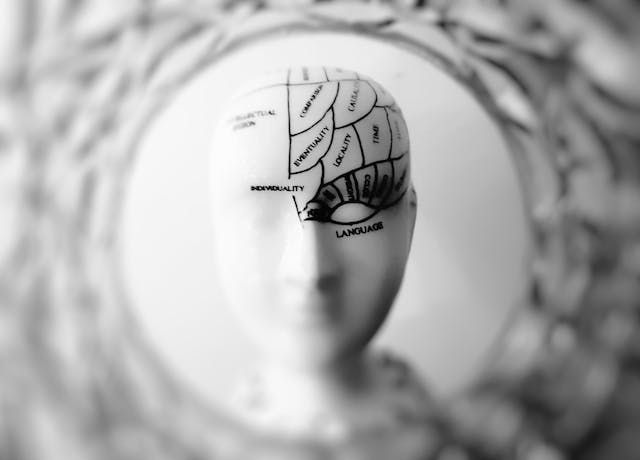
For many individuals, the concept of mindfulness is synonymous with practices like meditation and visualization. However, what happens when visualization doesn't work for you? How can you still cultivate mindfulness and reap its benefits? In this blog post, we will explore alternatives to traditional mindfulness practices for those who struggle with visualization or meditation. From tailoring the techniques to the individual to incorporating EMDR therapy, there are plenty of options to explore. Let's dive in and discover new ways to embrace mindfulness.
Understanding the Challenges of Traditional Mindfulness Practices

Traditional mindfulness practices like meditation and visualization are celebrated for their benefits in enhancing mental well-being and promoting a state of calm. However, these methods aren't universally effective, posing unique challenges for some individuals. For those who find it difficult to generate mental images, the common visualization techniques can feel frustrating and exclusionary. Similarly, meditation, with its emphasis on stillness and quieting the mind, can be daunting for people who experience restlessness or have an overactive mind.
This discrepancy highlights a crucial point: mindfulness is not a monolithic practice. It is a varied landscape of techniques, each with its own set of obstacles for different people. Recognizing and acknowledging these challenges is the first step toward opening the door to a broader understanding of mindfulness. It underscores the necessity of exploring a range of practices that can accommodate diverse experiences and preferences. As we navigate through these challenges, it becomes evident that flexibility and adaptability in our approach to mindfulness can lead to a more inclusive and beneficial experience for all.
The Importance of Tailoring Mindfulness to the Individual

Mindfulness is not a one-size-fits-all journey. Each person's experiences, challenges, and preferences shape how they can best engage with mindfulness practices. Recognizing this diversity is essential in making mindfulness accessible and effective for everyone. If traditional methods like visualization don't align with your abilities or preferences, it's crucial to remember that this doesn't exclude you from practicing mindfulness. Instead, it invites an opportunity to get creative and explore other techniques that might resonate more deeply with you.
Exploring different mindfulness practices is an act of self-compassion and personal understanding. Whether it's through mindful movement practices such as yoga or tai chi, focusing on the sensations of your breath, or engaging in daily activities with full awareness, there are myriad ways to cultivate mindfulness. The goal is to find practices that not only accommodate your needs. You must also enrich your daily life with moments of presence and awareness.
Engaging with practices that are in harmony with your individual needs can transform your mindfulness journey. This can be from one of frustration to one of discovery and growth. By remaining open to experimentation, you give yourself the space to uncover practices that support your well-being. This can lead to a deeper sense of mindfulness. This personalized approach ensures that your mindfulness practice is not only sustainable but also a source of joy and discovery in your life.
Practical Mindfulness Techniques Without Visualization
Exploring mindfulness beyond visualization opens up a wealth of possibilities for engaging with the present moment in a meaningful way. For those who find it challenging to conjure mental images, focusing on tangible, sensory experiences can serve as an effective alternative. One simple yet powerful technique is mindful listening. This practice involves paying full attention to the sounds around you. This can be the rhythmic patter of rain, the distant hum of traffic, or the subtle shifts in a room. By tuning into the auditory landscape, you can anchor yourself in the now without the need for visualization.
Another approach is to engage in tactile activities that ground you in the physicality of the present. Activities such as kneading dough, playing with clay, or even the act of cleaning can become mindfulness exercises. Just approach it with full awareness of the sensations in your hands and the movements of your body. These activities offer a direct pathway to mindfulness by leveraging the sense of touch, drawing your focus away from the whirlwind of thoughts and into the realm of tactile experience.
Mindful eating presents yet another avenue for cultivating mindfulness without visualization. By slowing down and truly savoring each bite, paying attention to the textures, flavors, and aromas of your food, you transform a routine activity into a deliberate practice of presence. Each of these techniques provides a unique way to experience mindfulness. It emphasizes the richness of the present moment through the senses rather than through visual imagery.
The Role of EMDR in Achieving Mindfulness
EMDR (Eye Movement Desensitization and Reprocessing) offers a unique contribution to the mindfulness journey, especially for individuals grappling with trauma. Although it primarily serves as a therapeutic tool for processing traumatic memories, its benefits extend to enhancing mindfulness. EMDR facilitates a deep engagement with the present moment. This is done by addressing and healing the emotional distress that can tether the mind to past events. This therapeutic process encourages an increased awareness and acceptance of one’s emotional state and thought patterns. It lays the groundwork for a more mindful way of living.
Through bilateral stimulation, typically involving eye movements, EMDR helps to unlock emotional processing that may be stuck, allowing individuals to experience relief from emotional blockages. As these blockages are addressed, individuals often find it easier to access states of mindfulness. This is due to their capacity for emotional regulation and presence in the now that is significantly improved. Engaging in EMDR therapy under the guidance of a skilled practitioner not only aids in the healing of past wounds but also enriches the pursuit of mindfulness by fostering a deeper connection with the self and the surrounding world.
Incorporating Mindfulness into Daily Activities

Integrating mindfulness into the fabric of everyday life can transform mundane tasks into opportunities for presence and awareness. Instead of seeing activities like brushing your teeth, taking a shower, or commuting to work as mere chores or routines, view them through a mindfulness lens. Focus on the feel of the toothbrush against your gums, the water cascading over your skin, or the rhythm of your footsteps. Each action offers a chance to ground yourself in the current moment.
Notice the colors, sounds, and sensations around you without judgment. Pay attention to your breathing as you move through these tasks. Allow each breath to bring you closer to a state of calm and focus. This practice doesn't require extra time out of your day but simply a shift in perspective and intention. By embedding mindfulness into these daily activities, you create a continuous thread of awareness throughout your day. This can make mindfulness an accessible and seamless part of your life.
Mindfulness Apps and Tools That Don't Rely on Visualization
In our technologically advanced world, a vast array of mindfulness resources is available at our fingertips. They are designed to cater to those who may not find visualization-based practices accessible or effective. Various applications and digital platforms provide a wealth of guided exercises, focusing on techniques such as mindful breathing, auditory practices, and body scans that do not require the user to visualize but instead to tune into other senses or aspects of their experience.
For example, Insight Timer features a wide range of mindfulness and meditation sessions focusing on sound. It has thousands of guided audio meditations from practitioners around the globe. Similarly, Headspace offers sessions centered on mindful techniques like noting and body scanning. This encourages users to pay attention to their thoughts, feelings, and physical sensations without the need to visualize. The Calm app also provides a plethora of mindfulness exercises, including daily calm sessions and sleep stories, that focus on the auditory experience and the practice of being present through listening and sensing.
These tools not only support those who prefer or require alternatives to visualization-based mindfulness but also enhance accessibility. It allows users to explore mindfulness in a way that aligns with their personal preferences and needs. By integrating these apps and tools into your mindfulness practice, you can discover new pathways to presence and awareness without relying on visual imagery.
The Benefits of Non-Traditional Mindfulness Practices
Embracing non-traditional mindfulness practices offers a multitude of advantages for those seeking alternatives to visualization and conventional meditation. These practices encourage an exploration of mindfulness through diverse sensory experiences and activities. This allows for a broader understanding and appreciation of the present moment. By engaging in mindfulness techniques that utilize sound, touch, or mindful movement, individuals can discover a deeper connection to their environment and inner self.
This inclusive approach ensures that mindfulness is accessible to everyone, regardless of their ability to visualize or sit in meditation. It promotes a sense of grounding and awareness that is both practical and profound, integrating seamlessly into everyday life. As you embark on this varied mindfulness journey, you will likely notice an enhancement in your capacity for emotional regulation, stress reduction, and overall well-being. The flexibility and adaptability of non-traditional mindfulness practices make them a valuable resource for cultivating a peaceful mind and a more mindful life, tailored uniquely to each individual's path.

In the world of trauma therapy, the journey towards healing is often likened to tending to a garden. Just as mowing the grass can provide immediate relief, it is equally important to uproot the weeds. This uproots the deep-rooted traumas and triggers that continue to cause distress. This blog post delves into the significance of going beyond the surface. It addresses the core issues that underlie our struggles in therapy. By embracing all of our parts and committing to the deep, transformative work, we can experience profound personal growth and transformation.
The Allure of Quick Fixes in Our Healing Journey

In the modern quest for instant gratification, it's tempting to seek out immediate, albeit temporary, solutions to our mental health challenges. This propensity for quick fixes is especially pronounced when we face the daunting complexities of trauma. Rather than embarking on the arduous journey of uncovering and addressing the root causes of our pain, we may find ourselves gravitating towards strategies that offer swift relief.
These strategies, akin to putting a band-aid on a deep wound, can momentarily ease our symptoms but fail to heal the underlying injuries.
The lure of these superficial interventions is understandable; they promise a reprieve from our discomfort with minimal effort and time. However, they bypass the crucial process of engaging with and resolving the core issues that perpetuate our suffering. By relying on these temporary fixes, we risk remaining ensnared in a cycle of distress, missing the opportunity for true healing and growth that comes from confronting and working through our traumas. It's essential to recognize the limitations of these short-term solutions and muster the courage to embark on the more challenging, yet ultimately more rewarding, path of deep therapeutic work.
Understanding the Depth of Our Weeds: Trauma and Triggers

Just like invasive species that can overtake a healthy garden if left unchecked, trauma and triggers can deeply entrench themselves in our psyche, often lurking unseen until they suddenly sprout into our consciousness, causing turmoil and distress. These roots of our issues are not always visible on the surface, making them challenging to identify and address without deliberate and careful exploration. They stem from past experiences that have left a lasting impact, influencing our reactions, behaviors, and relationships in ways we might not fully understand.
To effectively deal with these underlying problems, it's crucial to adopt an approach that goes beyond mere symptom management. This involves a willingness to delve into the uncomfortable and painful memories that feed our triggers and sustain our traumas. Engaging in this type of introspection allows us to uncover the origin of our distress. It provides us with the insight needed to begin the healing process. It requires courage to confront these aspects of our past. With that, we can start to disentangle the complex web of emotions and reactions that hold us back. This will result in genuine recovery and emotional freedom.
The Challenge of Accessing the Logical Brain During Crises

When confronted with a crisis, our brain's instinctual responses often take the wheel, sidelining our capacity for logical thinking. This shift occurs as the limbic system, designed to protect us through fight or flight reactions, dominates our mental processes. As a result, our ability to think rationally, solve problems, and make clear decisions is greatly diminished. This natural reaction to threat or stress complicates the journey of healing from trauma. It hinders our ability to engage with and process our deepest pains in the moment they are most activated.
Overcoming this challenge is a critical step in trauma therapy. This seeks to equip individuals with strategies to soothe the limbic system's alarm signals. Techniques such as focused breathing, mindfulness, and grounding exercises serve as bridges, enabling a transition from the heightened state of emotional turmoil to a place where the prefrontal cortex, the center of reasoned thought, can regain its guiding role. By fostering this shift, individuals can better navigate the turbulent waters of emotional crises. It sets the stage for the deeper exploration and resolution of traumas and triggers that lie at the heart of their healing journey.
Embracing All Parts of Ourselves for True Healing

The journey toward profound healing necessitates an acceptance of every facet of our being. This includes those we might wish to ignore or alter. This embrace is not about condoning past actions or denying the impact of our experiences. Rather, it's about acknowledging that each element of our identity, from our brightest joys to our deepest sorrows, contributes to the mosaic of who we are. In the landscape of trauma therapy, this holistic acceptance acts as fertile soil, nurturing growth and resilience. It involves peering into the shadows of our experiences with compassion. We then recognize that our vulnerabilities and scars are not marks of failure but signs of our humanity and strength.
This comprehensive self-acceptance paves the way for transformative healing. It allows us to integrate all parts of our experiences into a unified sense of self. Through this process, we learn not only to live with our past traumas and triggers but to understand their role in our current narrative, enabling a more compassionate and empowered approach to life. Embracing every aspect of ourselves becomes a pivotal step in the healing journey. It can foster a deeper connection to our innermost selves and supports a path toward true and lasting healing.
The Commitment to Deep, Transformative Work
Embarking on the road to recovery demands a steadfast dedication to confronting and working through the core issues that fuel our traumas and triggers. This journey, while challenging, asks us to venture into the depths of our past experiences. It asks us to face the discomfort and pain that have long been buried. It's a process that might lead us through dark and uncharted territories of our psyche. We might be required to scrutinize our most deeply rooted beliefs and emotions. The work is intense and often unsettling. It may include the examination of painful memories and the dismantling of protective barriers we've constructed around our vulnerabilities. However, it is through this deep, introspective work that we unlock the potential for profound change and healing.
Engaging fully in this transformative process enables us to emerge with a renewed sense of self-awareness and empowerment. The path may be arduous, filled with moments of doubt and resistance, but it is precisely this commitment to navigating the intricacies of our inner landscape that lays the foundation for genuine and enduring healing. This deep dive into the essence of our being is not a journey that can be undertaken lightly. It is the key to unlocking a future where our traumas no longer dictate our lives.
Tools and Strategies for Unearthing and Addressing Trauma
Navigating the terrain of trauma requires a tailored arsenal of therapeutic techniques. Mindfulness and somatic experiencing offer gateways to reconnecting with the present moment. It grounds individuals in their bodily sensations to foster a sense of safety. EMDR (Eye Movement Desensitization and Reprocessing) provides a structured approach to diminishing the vividness and emotional charge of traumatic memories . It facilitates a more adaptive integration of these experiences. Cognitive-behavioral therapy (CBT) targets maladaptive thought patterns and behaviors, laying the groundwork for new, healthier ways of interpreting and interacting with the world.
Each of these methodologies serves a unique function in the healing process. They each cater to the diverse needs and preferences of those seeking to overcome trauma. Central to the efficacy of these tools is the therapeutic alliance. This collaborative partnership empowers individuals to explore their vulnerabilities in a supportive environment. Through these varied strategies, tailored to the individual's journey, healing becomes not just a possibility but a tangible path forward.
The Path Forward: Nurturing Your Inner Garden for Lasting Wellness

Embarking on a journey of self-discovery and healing is akin to nurturing a delicate and vibrant garden. It demands continuous attention, care, and a gentle hand to guide its growth. As we delve into the depths of our traumas and confront our triggers, it's vital to remember the importance of self-compassion and patience. Healing, much like gardening, does not adhere to a strict timetable and its progress can sometimes be imperceptible. However, each small step taken towards understanding and resolving our inner conflicts contributes significantly to the health and vitality of our inner landscape.
Cultivating resilience is an integral part of this process. Just as a gardener learns to adapt to changing seasons and unexpected challenges, we too must learn to navigate the ebbs and flows of our emotional well-being with grace. This includes recognizing when to push forward in our therapeutic journey and when to rest and reflect on our progress.
Moreover, surrounding ourselves with a supportive community can act as a trellis, offering us stability and encouragement as we grow. Engaging in practices that ground us in the present, such as mindfulness and somatic experiencing, can also enhance our connection to our inner world, making it more manageable to tend to our needs with kindness and understanding.
As we continue to invest in our inner garden, we nurture the possibility of a future replete with strength, healing, and profound personal transformation.

In today's fast-paced world, where stress often feels like a constant companion, the significance of self-care cannot be overstated. It’s not merely an indulgence for those with too much time on their hands; it’s a vital component of a balanced life, essential for both physical and mental health. By dedicating time to self-care, we empower ourselves to not only survive but flourish. Through therapy, self-awareness, and a commitment to our well-being, we can unlock a transformative power that fosters personal growth, enhances our relationships, and allows us to break free from the shackles of self-destructive patterns.
Understanding the Foundation: What is Self-Care?
Self-care is a multifaceted practice that encompasses various activities and habits aimed at nurturing one's health and happiness. It’s the deliberate action of engaging in behaviors that promote well-being and reduce stress across all facets of our existence—physical, emotional, psychological, and spiritual. This concept transcends mere survival; it's about thriving. By prioritizing self-care, we listen to and honor our body's needs, whether it’s through nourishing foods, adequate rest, physical activity, or engaging in hobbies that feed our soul.
It means setting aside time for introspection and mindfulness, allowing ourselves moments of quiet and reflection. Importantly, self-care involves recognizing the signs when professional assistance is needed to navigate life’s more complex challenges and embracing the strength it takes to seek out that help. Far from being an act of indulgence, self-care is an act of self-respect. It requires us to tune into our needs and make conscious decisions to support our own growth and happiness. By investing in our well-being, we cultivate a stronger foundation from which we can support others, contribute to our communities, and face life's adversities with resilience. Engaging in self-care is a deeply personal journey, one that looks different for everyone but is universally vital for a balanced and fulfilling life.
Therapy: A Guiding Light in the Journey of Self-Care

In the pursuit of a well-rounded self-care routine, therapy stands as a pivotal component. It offers a unique environment for deep self-exploration, allowing individuals to confront and understand their emotions, thoughts, and actions in a profound way. This introspective journey is facilitated by a trained professional who guides the process of uncovering and addressing the root causes of distress and dissatisfaction in life.
One of the most empowering aspects of therapy is its ability to illuminate patterns of behavior and thought that may be obstructive. By bringing these to light, individuals can actively work towards modifying them. This paves the way for significant personal growth and improved mental health.
Therapy also serves as a catalyst for developing robust coping mechanisms. This enables people to manage stressors more effectively and maintain a sense of balance amidst life's ups and downs.
Moreover, therapy assists in the cultivation of healthy boundaries. Understanding and asserting one's needs within interpersonal relationships is a critical skill that therapy nurtures. This not only enhances personal well-being but also enriches the quality of connections with others. Through the therapeutic process, individuals learn to communicate their needs and limits clearly and confidently, contributing to more fulfilling and supportive relationships.
As an integral element of self-care, therapy underscores the importance of self-advocacy and resilience. It encourages a proactive approach to mental health, emphasizing that seeking support is not a sign of weakness, but rather a step towards empowerment and self-compassion. Engaging in therapy is a profound act of self-care that fosters resilience, self-understanding, and ultimately, a more gratifying life journey.
Integrating Self-Care into Daily Life: Practical Tips
Incorporating self-care into your routine might seem daunting, but it can be achieved with deliberate, simple steps. Begin by identifying moments throughout your day that can be dedicated to self-care activities. It could be a morning ritual of meditation to set a positive tone for the day. It could also be a brief midday walk to disconnect and recharge. Going on a weekend trip can be relaxing, but it's ok to start small. Consider integrating practices that engage your senses and bring you into the present moment. This can be something like, listening to soothing music or savoring a favorite cup of tea.

Experiment with various activities to discover what truly rejuvenates you. It might be reading, painting, or practicing yoga. The key is to actively make space for these activities, recognizing them as essential to your well-being.
Additionally, explore the power of digital detoxing. Allocating specific times to unplug from electronic devices can significantly reduce stress and improve your mental clarity. Use this time to connect more deeply with yourself and your loved ones.
Setting clear boundaries is crucial for protecting your self-care time. Learn to comfortably decline invitations or requests that conflict with your self-care commitments. It's about respecting your own needs and recognizing that doing so allows you to show up more fully in all areas of your life.
Remember, the journey of integrating self-care is highly personal and evolves over time. Stay flexible and kind to yourself as you navigate this process, adjusting your approach as your needs and circumstances change.
Breaking Free: Overcoming Barriers to Self-Care
Navigating through the obstacles that hinder our self-care journey requires intention and resilience. One of the foremost barriers many of us encounter is the pervasive feeling of guilt for taking time for ourselves. This is rooted in the misconception that self-care is selfish. It’s crucial to reframe our perspective. Understanding that self-care actually equips us to better support and engage with those around us. Time constraints also pose a significant challenge. This can be addressed by reevaluating our priorities and commitments, ensuring that self-care is viewed as non-negotiable rather than an afterthought.
Societal pressures add another layer of complexity, promoting a culture where being perpetually busy is often celebrated. Pushing back against this narrative involves cultivating an awareness that true productivity includes investing in our well-being. Identifying the specific factors that make self-care seem inaccessible is the first step toward dismantling them. Strategies such as setting realistic goals, integrating self-care in small increments throughout the day, and seeking solidarity with others who affirm the importance of this practice can make a considerable difference.
Another effective approach is leveraging resources and tools designed to facilitate self-care. Whether it's using apps that promote mindfulness, joining support groups that foster accountability, or simply scheduling self-care activities in your calendar as you would any important appointment, these tactics can help bridge the gap between intention and action. By proactively confronting and creatively overcoming these barriers, we pave the way for a more balanced and self-compassionate lifestyle.
The Role of Community in Your Self-Care Journey

A nurturing and understanding community is indispensable in amplifying the effectiveness of your self-care regimen. Having people around who echo your commitment to well-being not only validates your efforts but also strengthens your resolve. Engaging with such communities, whether they are found in local clubs, online forums, or among a circle of friends, can provide a rich source of inspiration and encouragement. This support network can introduce you to new perspectives and self-care practices. It can enhance your own repertoire of strategies for managing stress and promoting health.
Active participation in these communities allows for the exchange of self-care experiences and strategies, offering insights that you might not have considered. This collective wisdom can be particularly empowering, helping you to overcome challenges and stay motivated. Furthermore, these relationships foster a sense of accountability. Most times, sharing your goals and progress with others can make the journey more tangible and achievable.
In addition to offering support, these communities can also be a platform for you to give back, creating a symbiotic environment where everyone grows together. Teaching and supporting others in their self-care journey can reinforce your own practices and deepen your understanding of what self-care means to you.
Connecting with others who prioritize self-care can also help mitigate feelings of isolation, reminding you that you’re not alone in your efforts to nurture your well-being. This shared journey can make the path to personal growth and resilience less daunting and more enriching.
Measuring Progress and Adjusting Your Self-Care Strategy
Evaluating the impact of your self-care routine is crucial for maintaining its relevance and effectiveness in promoting your overall well-being. Periodically take stock of how your chosen activities contribute to your sense of balance, resilience, and fulfillment. Ask yourself whether these practices are meeting your current needs or if there are areas of your life that require more attention. It's essential to recognize that as your life evolves, so too should your self-care strategy. This may mean exploring new self-care practices that align with your changing circumstances or interests, such as incorporating mindfulness techniques if you find yourself facing increased stress, or seeking out social activities if you're craving more connection.
Adjustments to your routine should be made with compassion and flexibility, understanding that what works for you today might not be as effective tomorrow. Keep in mind the importance of boundary setting discussed earlier, ensuring that your self-care time is protected even as you experiment with new strategies. Also, don't hesitate to lean on your support network or consider professional guidance to navigate these changes.
Celebrating your successes is key. Acknowledging every positive step you take reinforces your commitment to self-care and can motivate you to continue. These moments of celebration, no matter how small, are reminders of your progress on this journey of self-improvement and personal growth.

Understanding and acknowledging the existence of highly sensitive individuals in our society can be a key element in cultivating empathy and compassion. Being highly sensitive isn't a flaw, but rather, it is a trait that should be embraced and understood. However, in a world that often values toughness and emotional durability, those who feel deeply and are highly attuned to their environments may sometimes feel overwhelmed.
Evolutionary Roots of High Sensitivity
The origins of heightened sensitivity can be traced back to the earliest roots of evolution, serving as a survival advantage across diverse species. This trait, common to numerous animals including humans, likely played a crucial role in our ancestors' survival.
Highly sensitive individuals possess an acute awareness of their environment, registering subtle changes and potential hazards that might elude others. These individuals, with their heightened senses, may have functioned as crucial members in early human societies. They may have taken on roles such as lookouts or healers. They utilized their heightened perceptions to enhance the group's safety and wellbeing.
Moving into our modern era, this sensitivity trait continues to offer many benefits but also presents unique challenges. The flood of information absorbed by these individuals results in deep reflection, empathy, and innovative thinking. However, without proper coping mechanisms and understanding, these qualities can transform into stressors, fostering feelings of anxiety and overwhelm.
It's essential to recognize that the world has changed drastically from the early days of human society. The pace of life, environmental noise, and social expectations have escalated. It has intensified the sensory overload that highly sensitive individuals often experience. This modern world, replete with its loud noises, bright lights, and relentless information flow, can indeed be daunting for those who process information more deeply.
In essence, the same trait that was a survival advantage in earlier times can feel more like a burden in our contemporary society. However, this doesn't negate the value of high sensitivity. It merely emphasizes the importance of developing strategies to manage it effectively in the context of our modern world.
Modern Day Cultures and High Sensitivity
Navigating the intricacies of modern day cultures can pose significant challenges for highly sensitive individuals. The continual hustle and bustle, the onslaught of digital notifications, and the demand for rapid responses can be particularly overwhelming. Especially for those who process information more intensively.
Modern society's emphasis on extroversion and constant activity can often make the highly sensitive feel out of sync. Encounters with vibrant sensory environments, even if positive, can trigger discomfort and distress. Everyday activities, such as navigating public transport during peak hours or enduring loud music at a party, may cause disproportionate stress.

One of the contributing factors to these challenges is the societal misconception that equates sensitivity with weakness. There exists a prevalent cultural narrative that champions emotional resilience and disparages vulnerability. As a result, highly sensitive individuals often face undue pressure to 'toughen up' or 'get a thicker skin.' This pressure can come from external sources, such as peers, family, and societal expectations. However, it can also be self-inflicted, born from a misunderstanding of the highly sensitive trait.
These misconceptions and the resulting pressure can foster feelings of inadequacy and alienation among highly sensitive individuals. The cultural expectation to conform can often lead them to suppress their emotions. They can also deny their need for quiet and solitude.
Understanding the interplay between modern cultures and high sensitivity is the first step towards fostering an environment that respects and appreciates this unique trait. It is important to recognize that sensitivity is not synonymous with fragility. It is a sign of deep empathy and perceptiveness can help shift societal attitudes. After all, in a world that is often deafened by noise, the ability to listen deeply and feel profoundly is a rare and valuable trait.
We need to remember that being highly sensitive does not mean being weak. It signifies having a high level of emotional and sensory perception. It is a characteristic that, if recognized, respected, and properly managed, can bring immense benefits to the individual and society at large. By shedding the misconceptions and biases that associate sensitivity with weakness, we can create a more accepting and inclusive society that values the unique contributions of highly sensitive individuals.
Therapy for Highly Sensitive Individuals
Finding suitable therapeutic support can be pivotal for highly sensitive individuals. A therapist who specializes in working with this population can provide valuable tools. These include, coping strategies for managing overstimulation, establishing beneficial boundaries, and fostering a healthy sense of self-worth.
Therapy presents an opportunity for highly sensitive individuals to delve into their experiences and emotions within a judgement-free space. It can help validate their feelings, alleviate any sense of alienation, and foster a better understanding of their unique trait. This can result in a shift in perception, allowing them to see their high sensitivity as an asset rather than a hindrance.

Therapeutic work can also provide strategies for managing and mitigating the impact of environmental noise and social pressure. Techniques such as mindfulness, relaxation, and cognitive reframing can be incredibly helpful. Mindfulness can help regulate emotional responses, relaxation techniques can counteract the effects of overstimulation. Cognitive reframing can help change the way a situation is perceived, turning potential stressors into more manageable experiences.
Furthermore, therapy can support highly sensitive individuals in establishing and maintaining healthy boundaries. This can entail learning to communicate their needs effectively, asserting themselves in interpersonal relationships. It also includes, identifying and removing themselves from situations that cause undue stress. This way, they can better protect their mental and emotional health, and foster more balanced, fulfilling relationships.
Therapy can also help highly sensitive individuals better understand and navigate their relationship with modern cultures. Through therapeutic discourse, they can develop a better understanding of societal expectations and pressures, and how these may impact their well-being. They can learn how to stay true to their sensitive nature, while at the same time functioning effectively in a fast-paced, extroverted world.
In sum, therapy can be a powerful ally for highly sensitive individuals. It provides them with the tools they need to understand and leverage their high sensitivity, empowering them to lead fulfilling, balanced lives.
Tools for Emotional Protection

Beyond therapy, there are several additional techniques that highly sensitive individuals can utilize to safeguard their emotional health. A critical element in this emotional toolkit is the practice of self-care. This involves engaging in activities that promote rest and relaxation to counterbalance overstimulation. Anything from taking a quiet walk in nature to and disconnect from the digital world is enough.
Mindfulness and meditation practices can also be particularly beneficial for many thing. Managing the intense emotional reactions often experienced by highly sensitive individuals is one. By focusing on the present moment and calming the mind, these practices can help to moderate emotional responses, reducing feelings of overwhelm and anxiety.
Expressing emotions through creative activities is another effective strategy. Writing, art, music, or any other creative pursuit can serve as a valuable outlet for processing complex emotions and experiences. These activities allow for the expression of thoughts and feelings in a constructive and cathartic way. This help to relieve emotional tension and promote mental clarity.
Setting and maintaining boundaries is another vital aspect of emotional protection for highly sensitive individuals. This can involve learning to assertively communicate their needs to others, allowing themselves to take necessary breaks, or reducing their exposure to environments that they find overwhelming. Establishing these boundaries can help to preserve their emotional energy, preventing burnout and promoting overall wellbeing.
Lastly, it's important to remember the role of positive self-talk and affirmation in safeguarding emotional health. Highly sensitive individuals may sometimes fall into patterns of negative self-judgment due to societal pressures and misconceptions. By consciously cultivating a positive internal dialogue, they can combat these negative patterns, reinforcing their self-worth and the value of their sensitivity.
Overall, these tools and techniques form a comprehensive strategy for protecting and nurturing the emotional wellbeing of highly sensitive individuals. By incorporating these strategies into their daily lives, they can better manage their heightened sensitivity and turn it into a strength, rather than a source of stress.
The Power of Acceptance and Self-Understanding
Embracing and accepting high sensitivity as an integral part of one's being can result in a profoundly transformative journey. For highly sensitive individuals, this means no longer battling their inherent nature, but rather, learning to harness it and transform it into a formidable asset.
It's a powerful realization to understand that being highly sensitive is not a shortcoming, but instead, a distinctive way of interacting with and interpreting the world around us. This recognition can be a catalyst for self-compassion, letting go of self-judgement and embracing oneself wholeheartedly.
Equally significant is fostering societal understanding of high sensitivity. Dispelling stigmatization and advocating for environments that celebrate rather than suppress high sensitivity can empower these individuals to flourish.
Our societal tapestry is woven from threads of diversity, and the richness of experience brought by highly sensitive individuals forms a key part of this vibrant fabric. By embracing and supporting these individuals, we can co-create a society that honors and values the contributions of all its members, acknowledging the strength in sensitivity and the profound depth of experience it brings.

Moving to a new place can be an exciting journey with new opportunities and adventures. But let's face it, it can also be a bit scary and intimidating, especially when it comes to taking care of our mental health. Amidst unpacking boxes and exploring new streets, we must have access to evidence-based care and support for our mental well-being. Whether settling into a bustling city or a quiet neighborhood, finding mental health resources in your new community is a step towards feeling more at home. Less like you're navigating this big change alone.
Understanding Your Needs
Before you dive into Google searches or local directories, take a moment to think about what you need. Mental health isn't one-size-fits-all. The kind of support that works wonders for one person might not be the ticket for another.

Are you looking for a therapist to chat with weekly? Or maybe a support group where you can share experiences and meet people facing similar challenges? Or perhaps exploring art therapy could be your creative avenue to managing stress. Identifying your needs is like setting the destination in your GPS. It can make finding mental health resources in your new community much easier.
Starting Your Search
Okay, so you've got a good idea of what you need. Now, where to find it? Start with a simple online search or check out local community boards. But remember, not all heroes wear capes—some might be your new neighbors or coworkers. Don't shy away from asking for recommendations.
Local healthcare providers, like doctors and clinics, can also be a goldmine for referrals to therapists, counselors, and support groups. And let's not forget about social media; it's not just for cat videos and food pics. Many communities have Facebook or WhatsApp groups where you can get leads on local mental health resources.
Leveraging Local Resources
Your new community might be holding onto some amazing resources waiting to be discovered. Community centers often host workshops and events focused on well-being and mental health. The best part is that these centers are present everywhere, from the busy streets of NYC to its calming suburbs. Hospitals and local mental health clinics further contribute to this network. They provide direct access to counseling and therapeutic services that cater to individuals and groups alike.
Online and Virtual Support
Let's face it: we live in a digital age, and finding support online has never been easier. Online therapy platforms, for instance, bridge the gap between you and mental health professionals, allowing for flexible scheduling that fits into your life, not the other way around. Consider the benefits of mental health apps that promote mindfulness and stress management, providing tools and techniques at your fingertips anytime, anywhere.

It's essential, however, to ensure the resources you turn to are reputable. Look for platforms with verified professionals and check out user reviews to gauge their effectiveness. Engaging with virtual support groups can also offer comfort and connection, breaking down geographical barriers and creating spaces where open, honest conversations can flourish. The goal is to build a support system that is accessible, reliable, and tailored to your needs, ensuring no one has to navigate their mental health journey alone.
Building a Personalized Support Network
Crafting a personalized support network is like assembling your team of superheroes. They're there for you, ready to lend an ear, offer advice, or just hang out when you need a break. This network can include close friends, family members you’re comfortable contacting, neighbors, and even coworkers.
Engaging in community activities or hobbies you love can also be a fantastic way to meet like-minded individuals who can become part of your support system. But don't rush - taking your time building these connections is okay. Genuine relationships grow from shared experiences and trust, and they can become one of your most valuable resources.
Navigating Insurance and Financial Considerations
Figuring out insurance and how to afford mental health care can be tricky, especially in a new place. First, get to know your insurance plan's coverage for mental health services. That might involve a bit of detective work—like reading through your policy details or making a call to customer service—but it’s worth it to understand what kinds of support are accessible to you financially.
If your insurance puzzle seems tough to solve, don’t fret. Many therapists offer sliding scale fees based on income, and nonprofit organizations provide affordable services. The key is to keep asking and exploring until you find the right fit for your budget and needs.
Engaging with Support Groups
Sometimes, the best way to navigate a new chapter in your life is by connecting with people on the same page. Support groups offer a unique space where you can share your experiences, challenges, and triumphs with others who truly understand. Whether you’re dealing with anxiety, adjusting to life in a new city, or exploring paths like art therapy for emotional expression, there’s likely a group for it.

Whether moving to busy Brooklyn or charming Hoboken, there are plenty of group meetings in cozy cafes, community centers, and even online. In Brooklyn, especially, finding a support group that resonates with your experiences can make a significant difference. These gatherings are not just about sharing and listening. They're key steps in helping you feel at home in Brooklyn after your move, offering emotional support and practical advice that cater specifically to the unique vibes and challenges of the city.
Stepping Stones to Well-being
Finding mental health resources in your new community is more than just a task to check off your moving list; it's a foundational step toward building a fulfilling life in your new home. Whether navigating the lively streets of Manhattan or settling into a quieter locale like Weehawken, remember that support is out there. From traditional therapy and innovative approaches like art therapy to support groups and online resources, a world of help is waiting for you. And don't forget, whether you're dealing with complex post-traumatic stress disorder or just seeking someone to talk to, reaching out is a sign of strength.

In a world where adult depression is increasingly prevalent, finding effective ways to manage
this condition becomes crucial. Embracing lifestyle changes for managing adult depression is not
just about treating symptoms. It's also about transforming our daily lives to cultivate happiness
and well-being. So, let's embark on a journey of self-improvement and positivity together.
1 The Impact of Diet on Mental Health
One of the most important lifestyle changes for managing adult depression is related to the food
you consume. A balanced diet, rich in essential nutrients, significantly influences mood and
mental health.
Foods high in omega-3 fatty acids, such as fatty fish, flaxseeds, and walnuts, are known to
enhance brain function and may help alleviate symptoms of depression. Complex carbohydrates
in whole grains, fruits, and vegetables provide sustained energy and help regulate serotonin
levels, a key neurotransmitter in mood regulation.

It's essential to avoid high-sugar and high-fat foods, which can lead to energy crashes and
mood swings. Including probiotics and fermented foods in your diet can also support gut health,
which is increasingly linked to mental health. Remember, the aim is to create a diet plan that is
sustainable and enjoyable, forming a part of your lifestyle rather than being seen as a restrictive
dieting regime.
2 Fostering Strong Relationships
Strong, healthy relationships are vital in combating adult depression. A supportive network
comprising a caring partner, understanding friends, and close family offers emotional comfort
and practical assistance. Open communication and shared activities in a relationship are key.
They foster mutual support and understanding.
Moreover, couples therapy or relationship counseling can be invaluable. It addresses conflicts,
which is not unusual when one of the partners is suffering from depression, improves
communication, and deepens emotional connections. Seeking help for these issues strengthens
individual well-being and the relationship.
Also, it's essential to cherish these relationships. After all, they play a significant role in
supporting a depressed loved one - you. This support is a gift, contributing immensely to your
journey towards managing depression. It reinforces the importance of empathy and patience,
especially when depression is a shared struggle.
3 Quality Sleep: A Pillar of Mental Health
Sleep is a critical element in managing adult depression. The relationship between sleep and
mental health is bidirectional – poor sleep can lead to mood disturbances, and depression can
make it harder to get a good night’s sleep. Creating a sleep-conducive environment, establishing
a regular sleep schedule, and engaging in relaxation techniques before bed are key strategies for
improving sleep quality.
Avoiding stimulants like caffeine and minimizing screen time in the evening can also contribute
to better sleep. Sharing a bedtime routine with your partner can foster a sense of togetherness and
support, further aiding in relaxation and stress reduction. Good sleep hygiene benefits not just
individual well-being but also the health of your relationship, as both partners are better rested
and more emotionally available.
4 Professional Help: A Strong Ally in Managing Depression
Seeking professional help is a crucial aspect of managing adult depression, especially when
lifestyle changes alone are not sufficient. Experts like those at harmonyridgerecovery.com
highlight the potential for depression to lead to addiction, underscoring the importance of
professional intervention. Therapy, counseling, and, in some cases, medication can provide
the necessary support and guidance.

essential support and guidance.
These resources can be particularly helpful in understanding and managing the underlying causes
of depression, including recognizing the signs of trauma and addressing them effectively.
Professional help can also offer new perspectives and strategies for coping, complementing
the lifestyle changes, and providing a more holistic approach to managing depression.
5 The Benefits of Mindfulness
Mindfulness practices are essential in managing adult depression. These techniques, including
deep breathing, guided imagery, and meditation, help foster awareness. Importantly, they
break the cycle of negative thoughts that often accompany depression. Mindfulness reduces
stress, improves focus, and enhances emotional well-being.
Furthermore, these practices can positively impact relationships. They promote empathy,
patience, and active listening. Practicing mindfulness with your partner can strengthen your
bond. It supports you both in moments of stress and anxiety. However, in some situations,
mindfulness reveals deeper anxiety issues. Here, it's time for specialized anxiety therapy. This
therapy can address more complex concerns, complementing your mindfulness journey.
6 Exploring New Experiences for Personal Growth
Trying new activities and embracing new experiences play a significant role in managing adult
depression. Stepping out of your comfort zone and engaging in new hobbies or learning new
skills can provide a sense of achievement and joy.
These experiences can invigorate your life, offering fresh perspectives and breaking the
monotony that often accompanies depression. Whether traveling to a new destination, taking up
a new sport, or attending a workshop, these experiences can revitalize your outlook on life and
contribute to your overall mental wellness.
7 Enhancing Well-being Through Exercise
Regular exercise is a cornerstone in the management of adult depression. It's not just about
maintaining physical health; it's a vital component of mental well-being. Physical activities,
whether a structured gym workout, a soothing yoga session, or even a simple daily walk, trigger
the release of endorphins, natural mood lifters.

against depression.
These activities also help reduce stress and anxiety, improve sleep, and boost self-esteem.
Incorporating regular exercise into your routine improves your physical health and cultivates a
more positive mindset.
Engaging in these activities with a partner or a friend can be particularly beneficial, as it provides
a shared goal and mutual support, which strengthens the bond in a relationship. This joint pursuit
can be especially uplifting as you both witness and celebrate each other's progress and
achievements.
Finding Joy in Every Step
Having all of the above in mind, it's safe to conclude that lifestyle changes for managing adult
depression require a holistic approach that involves nurturing the body, mind, and soul. By
implementing these lifestyle changes, you're not just combating depression but creating a
foundation for lasting happiness and well-being. Remember, every small step counts; together,
we can walk towards a brighter, more joyful future.

Performance anxiety is a common struggle that affects individuals in various areas of their lives. Whether it be in school, work, or personal relationships, the fear of not meeting expectations can be overwhelming and paralyzing. For some individuals, this fear may stem from past traumas and experiences, leading to a condition known as post-traumatic stress disorder (PTSD). Fortunately, there are effective treatments for PTSD that can also help alleviate the symptoms of performance anxiety. In this blog post, we will explore the role of PTSD treatment in overcoming performance anxiety and unlocking one's full potential.
Understanding Performance Anxiety and Its Impact on Your Potential
Understanding the impact of performance anxiety on your potential is crucial in finding ways to overcome it. When we constantly worry about performing well, we become hyper-focused on our perceived failures and shortcomings, rather than on our strengths and abilities. This negative mindset can hinder our progress and prevent us from taking risks and stepping out of our comfort zones.
Performance anxiety can be particularly challenging for individuals who have experienced past traumas, leading to the development of post-traumatic stress disorder (PTSD). The symptoms of PTSD, such as anxiety, panic attacks, and depression, can intensify performance anxiety and make it even more debilitating.
However, it's important to remember that there are effective treatments for both PTSD and performance anxiety. Seeking therapy, such as trauma counseling or anxiety treatment, can provide tools and strategies to help manage and overcome these challenges. One evidence-based treatment for PTSD is Eye Movement Desensitization and Reprocessing (EMDR) therapy, which can help individuals process traumatic memories and alleviate symptoms.
By understanding the impact of performance anxiety on our potential and seeking appropriate treatment, we can break free from self-criticism, embrace confidence growth, and unlock our full potential in any field or area of our lives. It is possible to achieve inner calm and focus, set and achieve goals, and find balance in managing our self-expectations and dealing with pressure. Let's explore how to overcome performance anxiety and unleash our true potential.
Embracing Confidence Growth: Breaking Free from Self-Criticism

To overcome performance anxiety, it is crucial to embrace confidence growth and break free from self-criticism. Many individuals who experience performance anxiety are often their own worst critics, constantly questioning their abilities and berating themselves for any perceived shortcomings. This self-critical mindset can be detrimental to our self-esteem and hinder our progress towards reaching our full potential.
To embrace confidence growth, it is important to challenge these negative self-beliefs and replace them with positive and empowering thoughts. Recognize that making mistakes and experiencing setbacks are a natural part of growth and learning. Instead of dwelling on perceived failures, focus on your strengths and past achievements. Remind yourself of your unique talents and capabilities that have led you to where you are today.
Additionally, seeking support from others can be incredibly helpful in breaking free from self-criticism. Whether it be through therapy, counseling, or talking to trusted friends and family members, sharing your anxieties and fears can provide a fresh perspective and valuable insights. Consider exploring trauma treatment, such as Eye Movement Desensitization and Reprocessing (EMDR) therapy, which has shown promising results in alleviating anxiety symptoms and promoting confidence growth.
Remember, confidence is not about being perfect or never making mistakes. It is about recognizing your worth, embracing your unique abilities, and believing in your capacity to grow and overcome challenges. By breaking free from self-criticism and embracing confidence growth, you can unlock your full potential and thrive in whatever field or area of your life you desire.
Goal Setting: The Pathway to Success

Setting goals is a crucial step in overcoming performance anxiety and unlocking your full potential. Goals provide us with a clear direction and purpose, allowing us to focus our energy and efforts on what truly matters. When setting goals, it is important to be specific, measurable, achievable, relevant, and time-bound (SMART). By following this framework, you can create goals that are realistic and attainable, increasing your confidence and motivation.
Additionally, breaking down larger goals into smaller, more manageable steps can help reduce feelings of anxiety. Celebrating each milestone along the way will boost your self-esteem and keep you motivated to continue striving for success.
Remember, goal setting is not about perfection or comparing yourself to others. It is about personal growth and progress. By setting goals that align with your values and aspirations, you can navigate through performance anxiety with purpose and determination. Keep in mind that it is okay to adjust your goals as you learn and grow. The most important thing is to stay focused, stay motivated, and stay committed to unlocking your full potential.
Mastering Inner Calm and Focus: The Essential Ingredients to Excel
Mastering inner calm and focus are essential ingredients for excelling and unlocking your full potential. When we are overwhelmed by performance anxiety, our minds become cluttered with self-doubt and negative thoughts, making it difficult to stay focused and perform at our best. By practicing mindfulness and developing relaxation techniques, such as deep breathing exercises or meditation, we can cultivate a sense of inner calm and clarity.
Additionally, exploring therapeutic approaches like EMDR therapy can help individuals address past traumas and reduce the symptoms of anxiety and depression. EMDR therapy is a highly effective treatment that uses eye movements or other forms of bilateral stimulation to help individuals process and heal from traumatic experiences.
By incorporating these strategies into our daily lives, we can quiet the noise of self-doubt and anxiety, and create a space where we can focus and perform at our peak. Remember, mastering inner calm and focus takes practice and patience, but the rewards are well worth it.
Overcoming PTSD as a Step towards Self-confidence and Unleashing Potential

Overcoming PTSD is a crucial step towards gaining self-confidence and unlocking your full potential. Post-traumatic stress disorder (PTSD) can intensify performance anxiety, making it even more debilitating. The symptoms of PTSD, such as anxiety attacks and depression symptoms, can hold you back from reaching your goals and embracing your true abilities.
Seeking appropriate treatment, such as EMDR intensive therapy, can help individuals process and heal from traumatic experiences, reducing the symptoms of PTSD and enhancing overall well-being. This therapy focuses on reprocessing traumatic memories, allowing you to release the negative emotions associated with them. As you heal from past traumas, you will experience a newfound sense of self-confidence and resilience, enabling you to overcome performance anxiety and unlock your full potential.
By taking the necessary steps to overcome PTSD, you are paving the way for personal growth and success. Remember, it is never too late to seek help and reclaim control of your life. You have the power within you to overcome PTSD and unleash your true potential.
Achieving Balance: Healthy Self-expectations and Dealing with Pressure
Achieving balance between healthy self-expectations and dealing with pressure is a crucial step in overcoming performance anxiety and unlocking your full potential. It's important to recognize that while setting high standards for yourself is beneficial, setting unrealistic expectations can be counterproductive and contribute to feelings of anxiety and overwhelm.
To achieve balance, start by being kind and compassionate towards yourself. Remind yourself that it's okay to make mistakes and that setbacks are a part of growth. Focus on progress rather than perfection and celebrate small victories along the way.
Managing pressure is also essential. Break tasks into manageable chunks and prioritize self-care. Find healthy coping mechanisms like exercise, journaling, or spending time with loved ones to reduce stress. Setting boundaries and learning to say no when necessary can also help manage external pressures.
Remember, balance is about finding harmony between striving for success and taking care of your well-being. By maintaining healthy self-expectations and effectively managing pressure, you can navigate performance anxiety with grace and confidence, ultimately unlocking your true potential.
Many of my clients have difficulty living the life they want and need to feel truly happy. They struggle with expectations placed on them by others, feelings of guilt if they put themselves first and most days feel like they cannot catch their breathe. Trauma therapy, like EMDR for example, can help you to end old patterns and put yourself first. Self-care isn't selfish- I know it's a clique but it is true. You need to take care of you to be your best self for your family, friends and career. If this is speaking to you, strap in- I have some Pro-tips for you.

1. Evaluate Your Values
What is most important to you? List 3 things. Could be family, honesty, integrity, compassion, trust etc. Then you need to start seeing if your actions actually align with your values. Those that do keep at them- those that don't make an effort to change them. For example, if you choose "family, compassion and health" and you are offered an additional work shift. Is taking this shift detracting from your family time? Do you need a mental health break or day off to take care of you? If so say no. If it's to help a colleague who is going through a rough time and you feel you have enough time on another day to take care of you and spend time with family and you want to honor that "compassion" value you can also say yes. Seeing how our actions are in align with our values helps us to begin living a life that makes us happy- not a life that is spent trying to appease or please others.
2. Set Some Boundaries
In set with setting those values is setting up some boundaries with those around us. When we have no boundaries- meaning we having difficulty saying no or often do things out of pleasing others even if it's not what we want- we continue to feel exhausted, unhappy and overwhelmed. Boundaries despite what childhood may have taught you are actually healthy.

Saying "No I'm sorry I can't go out tonight", "No I won't be able to take on that extra project with my current workload as it stands" or "I would appreciate if you refrained from "xyz" in front of my children" is the first step to reducing our triggers, reducing your stress load and giving yourself the time to focus on you and do what makes YOU happy.
3. Let Go of the Guilt
Often times my clients struggle with boundaries because of the guilt they feel in saying no to others. They feel responsible to take on the problems of those around them. They are accustom to the role of "fixer". Those around them, often family members but sometimes even colleagues or bosses sometimes push back on boundaries set and plead or ridicule them if they don't get what they want. I'm not going to say setting boundaries is an easy task when you are accustom to saying "yes" to everything because your role has always been to put others before you. But I will say the more you stick to your boundaries, the less others push back over time. It helps to see if keeping those boundaries is in alignment with your values or the type of person you are aspiring to be. Simple answer might look like "yes, I value helping others." With a closer look though it's easy to see it is hard to be our best self for others when you are running on empty.

As I often tell my trauma therapy clients, and as they say on the air plane "put your mask on first" before you help those around you. It also helps to make a list of the short term positive gain of letting others violate your boundary and the long term consequences. For example, lets say you have difficulty saying no at work and are constantly taking on additional tasks asked of you.
| Short Term Positive of Not Holding My Boundary | Long Term Consequences of Not Holding My Boundary |
| -Don't feel guilty | -I am overwhelmed and burning out |
| -My boss is happy | -It's hard to complete additional work assigned in my work hours so I am constantly bringing work home |
| -I get positive praise | -I am working so hard that when I am done I have no energy to engage meaningfully with my husband and kids |
| -I feel taken advantage of and under appreciated | |
| -My workload will never decrease if I do not voice concern with the disproportionate work I get in comparison to colleagues |
After making this list you may decide to have a conversation with your boss and say "I would love to be able to help with that project but I already have 3 other projects I am currently working on. I will need to finish those first before I can take on any more. It's important to me that the quality of my work meets the standard and I am afraid I won't be able to complete all projects to our client's expectations." Starting an honest dialogue can help you feel more in control and will likely make you a better employee. Same with friends and family, when you are happier and more relaxed you can be your best self for your spouse, children, parents and friends. If this seems daunting, trauma therapy can surely help you work through your fears and doubts.
Need Help?
If this sounds daunting, you may need some extra support in navigating beginning to set boundaries and taking back control of your life. This is really common with clients who have trauma, are children of alcoholics, were parentified children (children that functioned more as parents), and those with low self-esteem and attachment difficulties (as they often fear boundaries will push others away). Trauma therapy can help! Just like my clients you can take back your life, begin to feel in control, less overwhelmed, more peaceful and joyful. You deserve happiness too. If you need the extra support in getting there give our office a call.
Sending love & light,

Have you ever wondered how childhood trauma impacts adolescents or adults? Do you find yourself asking yourself how much your childhood has a impact on your relationships today? Childhood experiences, both positive and negative, have major impact on our emotional development and how we continue to interact in the relationships around us.
Childhood is where our attachment styles are developed and our parents are our primary attachment figures. The way they respond to us in childhood shapes our worldview, or perception of the world, and how we expect others to respond, relate and interact with us. This is the foundation of whether or not a child will feel the world is safe and whether or not those around them will accept them.
Erikson called this our view of “trust or mistrust”. Is it a safe place to venture out and take emotional risks? Are all people generally good or are they out to hurt us and therefore untrustworthy? Can we trust others to support us in times of emotional need or crisis or do I need to rely on myself?
Complex trauma refers to the prolonged exposure to a stressful event, or repeated traumatic events layered on top of another. This would include children, who have grown up in physically, sexually, and/or emotionally absent or abusive households, as well as children who grew up in unsafe communities, an incarnated parent or a parent with mental health or substance use concerns.
How Childhood Trauma Continues to Effect us into Adulthood

Without the safety net of a secure attachment relationship, children experiencing childhood trauma grow up to become adults who struggle with poor self-esteem and difficulty with emotional regulation. They continue the unhealthy relationship patterns of their childhood with partners, friends and family members. These adults also have an increased risk of developing depression and anxiety.
The following are the four basic attachment styles. Please keep in mind that these descriptions are very general; not everyone will have all these characteristics. Attachment styles are relatively fluid and can be ever-changing depending on your partner’s own attachment style and the adaptations you make as you grow and learn.
Secure Attachment in Adults
These individuals usually grew up in a supportive environment where parents consistently responded to their needs. Securely attached individuals feel comfortable in their own skin, easily share feelings with partners and friends and seek out social support. These individuals have a generally positive outlook on life and seek physical and/or emotional intimacy with minimal fear of being rejected or overwhelmed.
Securely attached individuals, much like their parents were to them, are generally consistent and reliable in their behaviors toward their partner. They also tend to include their partner in decisions that could affect their relationship or life goals.
Dismissive-Avoidant Attachment in Adults
Children develop this attachment style when their primary caregivers are not emotionally responsive or are rejecting of their needs.
Children learn to pull away emotionally and be overly self-reliant, as means to avoid feelings of rejection. As adults, they become uncomfortable with emotional openness and downplay the importance of relationships.
These adults tend to place a high priority on their own independence from others and tend to be extremely self-reliant. They develop techniques to reduce feelings of being overwhelmed and defend themselves from perceived threats to their “independence.”
These techniques include, shutting down, sending mixed messages, and avoiding. These coping techniques end up becoming detrimental to their adult relationships.
Fearful-Avoidant Attachment in Adults
Children who have developed this style of attachment may have been exposed to prolonged abuse and/or neglect. Their primary caregivers are a source of hurt, rather than fulfilling their vital role of providing support and comfort.

These children grow up to become adults who depend on others but avoid intimacy in their relationships due to fear of rejection. As adults they have lower self-esteem and high anxiety in relationships.
As adults they see the value in having close relationships but due to the abuse they received have a difficult time trusting others. Due to this distrust, they avoid being emotionally vulnerable with others and have difficulty clearly expressing their wants and needs, as they fear it will lead to more hurt and rejection.
Anxious-Preoccupied Attachment in Adults:
Children with anxious-preoccupied attachment had caregivers who did not consistently meet their needs, as in their responses to the child were not consistent or predictable. Their parents were nurturing, caring and attentive at times but this was alternated with cold, rejecting or emotionally detached behaviors.
This alternation between love and rejection makes it difficult for a child to know what to expect from day to day. These children then grow up to be adults who require a lot of connection, closeness and attention within their relationships, sometimes to the point of being “clingy.”
Individuals who have this attachment style may need more validation and approval from loved ones than the other attachment styles.
Neurobiology of Attachment and Childhood Trauma

As products of our own environments, adults will often find themselves repeating the same behaviors witnessed and experienced in childhood. This is because the neural pathways developed from childhood traumatic experiences shape keep us stuck in these unhealthy patterns and ways of relating.
As products of our own environments, adults will often find themselves repeating the same behaviors witnessed and experienced in childhood. This is because the neural pathways developed from childhood traumatic experiences shape keep us stuck in these unhealthy patterns and ways of relating.
To say all of this is not meant to place blame on caregivers for the types of relationships formed in your adult life. However, increasing awareness of your own attachment style can help you take those first steps towards recognizing patterns and improving your relationships as an adult. With newfound awareness you can move to form securely attached relationships with your partner and with your own children.
Processing those difficult childhood memories of abuse and neglect can help you to make new neural connections with more adaptive experiences in your life and thus alter that inner-voice that keeps your stuck in poor patterns of behavior.
Where to go From Here?
At Long Island EMDR, we understand how complex childhood trauma affects you as an adult, which is why we specialize in EMDR and trauma-focused therapies. We are here to help guide and support you through your journey of processing past hurts and forming healthier connections.
Keep Shining,
Parenting is a challenging journey on its own, but it can become even more difficult when the parent has ADHD. The constant struggle to stay organized, focused, and on top of responsibilities can take a toll on both the parent and their child. However, there is hope. EMDR therapy, a unique and effective form of therapy, has shown promising results in helping parents with ADHD better manage their symptoms and become more confident and capable in their role as a parent. In this blog post, we will explore the struggles of parenting with ADHD and how EMDR therapy can be a valuable tool in navigating this challenge.
Understanding ADHD in Parents
Parenting is a challenging journey that requires patience, focus, and organization. But what happens when the parent themselves has ADHD? Attention-Deficit/Hyperactivity Disorder, or ADHD, is a neurodevelopmental disorder that affects both children and adults. It is characterized by difficulties in maintaining attention, hyperactivity, and impulsivity. When a parent has ADHD, it can add an extra layer of complexity to the already demanding role of being a caregiver.

Understanding ADHD in parents is crucial in order to navigate this unique challenge. For parents with ADHD, the struggle to stay organized and focused can make even the simplest tasks feel overwhelming. Time management becomes a constant battle, leading to feelings of frustration and guilt. The ability to juggle multiple responsibilities can become incredibly challenging, leaving parents feeling overwhelmed and inadequate.
Additionally, ADHD can also impact a parent's ability to provide structure and consistency for their child. The lack of organization and planning can lead to inconsistency in parenting styles, which can be confusing for the child and create additional challenges in their development.
It's important to recognize that ADHD is a real and valid condition that requires understanding and support. By acknowledging and addressing the specific challenges that parents with ADHD face, we can begin to develop strategies and interventions that can help alleviate some of the burdens they face. In the next section, we will explore the struggles of parenting with ADHD in more detail, shedding light on the daily obstacles that parents with ADHD must overcome.
Struggles of Parenting with ADHD
Parenting is already a challenging task, but when a parent has ADHD, it can become even more overwhelming. The daily struggles of managing ADHD symptoms while also trying to meet the needs of your child can take a toll on both the parent and the child.
One of the main struggles for parents with ADHD is the difficulty in staying organized and focused. Simple tasks that seem easy for others can feel insurmountable for someone with ADHD. Time management becomes a constant battle, and feelings of frustration and guilt can easily arise. Juggling multiple responsibilities can be incredibly challenging, leaving parents feeling on edge and not good enough.
ADHD can also affect a parent's ability to provide structure and consistency for their child. The lack of organization and planning can lead to inconsistency in parenting styles, which can be confusing and unsettling for the child. This can create additional challenges in their development and may cause the child to struggle with routine and expectations.
Furthermore, the impulsivity that often accompanies ADHD can also be a struggle for parents. Impulsive reactions and decision-making can lead to unintended consequences and can make it difficult to maintain a calm and controlled environment for the child.
Overall, parenting with ADHD is a daily battle. However, it's important to remember that you are not alone. There are strategies and interventions available to help parents with ADHD navigate these challenges and become more confident and capable caregivers. In the next sections, we will explore the benefits of EMDR therapy, how it works, and finding a therapist to guide you through this unique form of therapy.
Benefits of EMDR Therapy for Parents with ADHD
EMDR therapy, Eye Movement Desensitization and Reprocessing, has shown promising benefits for parents with ADHD. This unique form of therapy can help alleviate the struggles that come with parenting while managing ADHD symptoms. Here are some of the benefits of EMDR therapy for parents with ADHD:
1. Reduction of ADHD symptoms: EMDR therapy has been found to be effective in reducing the symptoms of ADHD, such as difficulties with attention, focus, and impulsivity. Through targeted eye movements or other forms of bilateral stimulation, EMDR therapy helps reprocess traumatic memories and negative beliefs that may contribute to ADHD symptoms.
2. Improved executive functioning: EMDR therapy can enhance executive functioning skills, such as organization, planning, and time management. By addressing underlying emotional issues and working through past traumas, parents can develop new coping strategies and improve their ability to stay organized and focused.

3. Enhanced self-confidence: Many parents with ADHD struggle with feelings of inadequacy and self-doubt. EMDR therapy can help parents develop a more positive self-image and improve their self-confidence as a parent. By reprocessing negative experiences and beliefs, parents can gain a greater sense of their strengths and abilities.
4. Improved parent-child relationship: EMDR therapy can also benefit the parent-child relationship. By addressing and resolving emotional issues that may contribute to parenting challenges, parents can develop healthier and more secure attachments with their children. This can lead to improved communication, trust, and overall family dynamics.
5. Long-lasting results: EMDR therapy has been found to have long-lasting effects. Many parents report continued improvements in their ADHD symptoms and parenting abilities even after therapy has ended. This means that the benefits of EMDR therapy can extend beyond the therapy sessions and have a positive impact on parenting in the long term.
How EMDR Therapy Works
EMDR therapy, Eye Movement Desensitization and Reprocessing, is a unique and effective form of therapy that has shown promising results in helping parents with ADHD. But how exactly does EMDR therapy work?
EMDR therapy is based on the understanding that traumatic or distressing experiences can get stuck in our brains, causing negative beliefs and emotional distress. These unresolved experiences can contribute to ADHD symptoms and difficulties in parenting. EMDR therapy works by targeting and reprocessing these traumatic memories, allowing the brain to process them more healthily.
During an EMDR therapy session, the therapist will guide the parent through a series of eye movements or other forms of bilateral stimulation. This bilateral stimulation helps stimulate the brain's natural ability to heal and reprocess traumatic memories. As the parent follows the therapist's hand movements or listens to sounds alternating in each ear, the brain's attention is split, allowing the distressing memories to be processed more effectively.
As the parent reprocesses these traumatic memories, they can experience a reduction in ADHD symptoms and an improvement in executive functioning. Negative beliefs about themselves as parents can be challenged and replaced with more positive and empowering beliefs. This leads to improved self-confidence and a stronger parent-child relationship.
EMDR therapy is a collaborative process, with the therapist providing a safe and supportive environment for the parent to explore their experiences and emotions. Each session builds on the progress made in the previous session, allowing for a gradual healing process.
Finding a Therapist for EMDR Therapy

Finding a qualified therapist who specializes in EMDR therapy can greatly benefit those managing ADHD symptoms and navigating the challenges of parenting. To find the right therapist for you, follow these tips:
1. Research online: Begin by searching online directories and therapist listings in your area. Look for therapists who specialize in EMDR therapy, have experience working with individuals with ADHD, and possess relevant credentials and experience. Read any reviews or testimonials from previous clients. The EMDR International Association website is a good start!
2. Seek recommendations: Reach out to your personal network for recommendations. Ask friends, family members, or support groups who have undergone EMDR therapy or know someone who has for their experiences. This can provide valuable insights and help you find a therapist who suits your needs.
3. Consult with professionals: Consider seeking recommendations from mental health professionals, such as psychologists or psychiatrists, who specialize in ADHD or trauma. They may be familiar with therapists who utilize EMDR therapy and can provide referrals.
4. Take advantage of consultation sessions: Many therapists offer free consultation sessions or phone calls to discuss their approach and answer any questions you may have. This can give you a better sense of the therapist and whether they are a good fit for you.
5. Trust your instincts: It is important to trust your instincts when choosing a therapist. Find someone you feel comfortable with and can build a strong therapeutic relationship with. Don't be afraid to ask questions and voice any concerns you may have during the consultation process.
Remember that finding the right therapist is a personal and individual process. Take your time, do your research, and trust that you will find the right therapist who can support you in managing your ADHD symptoms through EMDR therapy.
Other Resources and Coping Strategies for Parenting with ADHD
Parenting with ADHD can be a daily battle, but there are resources and coping strategies that can help alleviate some of the challenges and help you feel better connected with your family. Here are a few additional resources and strategies to consider:

1. Support groups: Connecting with other parents who also have ADHD can provide a sense of community and understanding. Support groups can offer valuable advice, tips, and a safe space to share experiences and frustrations. Look for local support groups or online communities specifically for parents with ADHD.
2. Parenting classes or workshops: Many organizations offer parenting classes or workshops specifically tailored to parents with ADHD. These classes can provide valuable strategies and techniques for managing ADHD symptoms while still being an effective parent. Check with local community centers, mental health clinics, or online resources for upcoming classes or workshops.
3. Time management tools: Utilize tools and apps that can help with time management and organization. There are various apps available that can assist with setting reminders, creating schedules, and breaking tasks into manageable chunks. Experiment with different tools to find the ones that work best for you and your family.
4. Prioritize self-care: Taking care of yourself is essential when parenting with ADHD. Make time for self-care activities, such as exercise, meditation, or engaging in hobbies that bring you joy. Remember, when you prioritize your well-being, you are better able to show up for your child.
5. Seek professional help: In addition to EMDR therapy, consider other therapeutic interventions that may benefit parents with ADHD. Cognitive-behavioral therapy (CBT) and medication management can also be effective treatments for managing ADHD symptoms. Consult with a mental health professional who specializes in ADHD to explore the best treatment options for you.
Remember, managing ADHD as a parent is an ongoing journey. It's essential to be patient with yourself, practice self-compassion, and celebrate your successes along the way. With the right resources and coping strategies, you can navigate the challenges of parenting with ADHD and thrive in your role as a loving and capable caregiver.